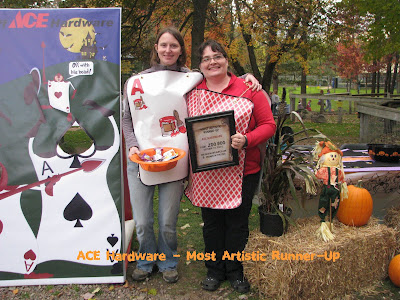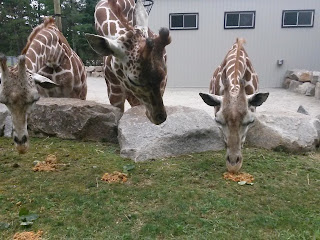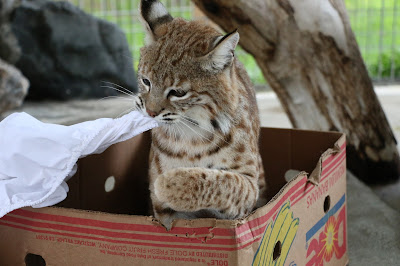Today we are featuring Hannah Arnott and Katie Quednow, Wildwood Wildlife Park interns who have chosen their favorite park residents to imitate as part of our National Zookeeper Week.
Hannah is showing off her pearly whites imitating our baby male zebra Zorro - it looks like both of them have something exciting to say about greeting our visitors to the park!
As you can probably guess, the zebra is closely related to horses and donkey but what sets zebras apart is their unique black and white stripes. Did you know that each of the animal's stripes are as unique as fingerprints, no two are alike. Theories abound as to why zebras have stripes including: to repel insects, provide camouflage in grassy areas, confuse predators, to reduce its body temperature, or to provide a way of zebras to recognize each other.
Zebras are herbivorous feeding primarily on a variety of grasses. They are also known to eat shrubs, twigs, leaves and bark.
Zebras are born with brown and white stripes, changing to the signature black and white as they develop into an adult. The foals have soft fuzzy fur and are able to walk within 20 minutes following birth and are able to run within one hour. Mares will keep other zebras away from her newborn for the first two or three days until her foal can imprint on her by sight, voice and smell.
Zebras are very social animals and live in large groups called a harem. Sometimes these harms will come together to form temporary groups of up to 30 members. Zebras sleep standing up and while in a group can be warned of danger. If they spot danger zebras will bark or whinny loudly to warn others in the group.
Wildwood intern Katie is striking a queenly pose in keeping with the the regal charm of the park’s black leopard Toby.
 Zoologically speaking, the term panther is synonymous with leopard. The black panther is the common name for a black "big cat" with a coloration melanistic gene that causes the beautiful black coloration. Did you know that Toby, like other black leopards are not totally black but rather have a spotted pattern which you can see from a certain angle. Underneath that beautiful fur their skin is a mixture of blue black gray and purple with rosettes.
Zoologically speaking, the term panther is synonymous with leopard. The black panther is the common name for a black "big cat" with a coloration melanistic gene that causes the beautiful black coloration. Did you know that Toby, like other black leopards are not totally black but rather have a spotted pattern which you can see from a certain angle. Underneath that beautiful fur their skin is a mixture of blue black gray and purple with rosettes.
Leopards live in sub-saharan Africa, northeast Africa, Central Asia, India, and China, however, much of their populations are endangered. The leopard is able to hunt and kill animals that significantly outweigh them. These nocturnal hunters are so comfortable with their climbing skills that they often hunt from trees and, using their impressive strength, will drag their kill high into a tree keeping it safe from scavengers such as hyenas.
Leopards can give birth at any time of the year, a typical litter will consist of two cubs. A mother leopard keeps her cubs hidden, moving the cubs frequently from one safe location to another until they are old enough to begin to play, a precursor of developing hunting skills. The cubs will stay with their mother for two years. Other then a cub with the mother, leopards are solitary animals.
Leopard populations are declining due to being hunted for their soft fur which is prized in the production of coats and robes. Poaching and habitat loss are the reasons why the population of leopards are relatively low. These beautiful big cats are in far more danger from humans than we are from leopards. When brought into close contact with human ranches, leopards may prey on livestock.













































